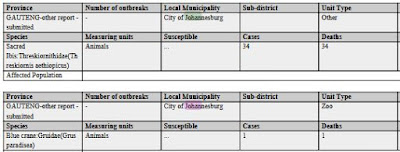#12,792
South Africa, which saw the arrival of HPAI H5N8 for the very first time last June, has reported 67 outbreaks to the OIE as of September 29th. Hardest hit has been the Western Cape region, where reportedly 2 million birds have been destroyed.
The capital city of Johannesburg has been largely spared - reporting no outbreaks in poultry and only two small outbreaks in non-poultry birds, including the death of a Blue Crane at the Joburg Zoo in late August.
This morning, however, multiple South African media outlets are reporting that several parks and the Joburg Zoo have recovered nearly 600 dead birds since September 1st, most of which have tested positive for the H5N8 virus.
Although I've not found a notice posted yet at the Johannesburg Zoo or City Parks websites, the following report from SAFRICA 24 is typical of what is being published this morning.
Joburg City Parks confirms outbreak of bird flu
Johannesburg - Avian influenza has hit Johannesburg with 598 carcasses of birds having been recovered from the City of Joburg facilities at Westdene Dam, Emmarentia Dam, Zoo Lake and and Joburg Zoo.
Johannesburg City Parks and Zoo (JCPZ) has confirmed that some of its facilities have been affected by the outbreak that was first detected in Limpopo and which has been spread by the seasonal migration of birds.
JCPZ spokesperson Jenny Moodley said that from September 1 to date, the facility has recovered over 548 carcasses and “most have tested positive for the strain of Avian Influenza that is not contagious to humans.”
All the dead birds are being incinerated and are being handled as per strict health and safety regulations, she said.
(Continue . . . )
After what appeared to be a relatively slow start in June, July and August, H5N8 reports from South Africa have roughly doubled over the past 30 days. Due to the limits of surveillance - particularly in remote and rural areas - the number of wild bird deaths are likely seriously under reported.
Since this is HPAI H5N8's first incursion into the Southern Hemisphere there have been a number of open questions over how well it would adapt to the local environment, and whether it would establish a foothold.This is important not only for South African poultry interests, but also to those who receive yearly visits from migratory birds from that region. An entrenched H5N8 virus in the Southern Hemisphere might not only afford it more opportunities to adapt or reassort with local viruses, it could conceivably change the way the virus spreads globally.
Although the jury is still out on these issues, today's report suggests that H5N8 is better entrenched in the local wild bird population than previous reports would suggest.


